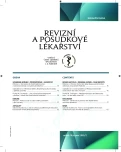Medicinal products and laboratory tests – do we really control it?
Authors:
M. Prokeš; J. Suchopár
Authors‘ workplace:
INFOPHARM, a. s.
Published in:
Reviz. posud. Lék., 18, 2015, č. 2, s. 50-56
Category:
Review articles, original papers, case report
Overview
In this review article authors want to draw attention to possible inappropriate prescribing when drugs altering kaliemia or magnesemia are prescribed without ordering appropriate laboratory tests. Hypokaliemia and/or hypomagnesemia increases risk of serious cardiac arrhytmia, such as torsade de pointes, which is rare but life threatening, especially when drugs prolonging QT interval are co-prescribed. Co-prescription of drugs afecting RAAS and mineralocorticoid receptor antagonists (MRA) can cause hyperkalemia, which can also kill patients. Recent abroad studies revealed, that physicians do not allways order appropriate laboratory tests to identify the drug risk. To identify the physicians and advice them should be within the abilities of health funds.
Keywords:
hypokaliemia – hypomagnesemia – hyperkaliemia – patient monitoring
Sources
1. McKibbin, J. K. et al. Br. Heart J., 1984, 51, p. 157–162.
2. Digby, G. et al. Cardiology Journal, 2010, 17, p. 184–188.
3. Morgan, D. B., Davidson, C. Br. Med. J., 1980, 280, p. 905–908.
4. Bibawy, J. N. et al. Circ. Arrhythm. Electrophysiol., 2013, 6, e17-e19. doi: 10.1161/CIRCEP.112.000101.
5. Hoorn, E. J. et al. Am. J. Kidney Dis., 2010, 56, p. 112–116.
6. Luk, C. P., Parsons, R., Lee, Y. P., Hughes, J. D. Proton pump inhibitor-associated hypomagnesemia: what do FDA data tell us? Ann. Pharmacother., 2013, 47, 6, p. 773–780.
7. Zipursky, J. et al. PLOS Med., 2014, 11, 9, e1001736, http://journals.plos.org/plosmedicine/article?id=10.1371/journal.pmed.1001736.
8. Pitt, B., Zannad, F., Remme, W. J. et al. The effect of spironolactone on morbidity and mortality in patients with severe heart failure. N. Engl. J. Med., 2009, 341, p. 709-717.
9. Pitt, B., Remme, W. J., Zannad, F. et al. Eplerenone, a selective aldosterone blocker, in patients with left ventricular dysfunction after myocardial infarction. N. Engl. J. Med., 2003, 348, p. 1309–1321.
10. Zannad, F., McMurray, J. J., Krum, H. et al. Eplerenone in patiens with systolic heart failure and mild symptoms. N. Engl. J. Med., 2011, 364, p. 11–21.
11. Wrenger, E., Müller, R., Moesenthin, M. et al. Interaction of spironolactone with ACE-inhibitors or angiotensin receptor blockers: analysis of 44 cases. BMJ, 2003, 327, p. 147–149, http://www.ncbi.nlm.nih.gov/pmc/articles/PMC1126510/.
12. Juurlink, D. N., Mamdani, M. M., Lee, D. S. et al. Rates of hyperkalemia after publication of the randomized aldactone evaluation study. N. Engl. J. Med., 2004, 351, p. 543–551.
13. Wei, L., Strthers, A. D., Fahey, T. et al. Spironolactone use an renal toxicity: population based longitudinal analysis. BMJ, 2010, 340, c1768.
14. Dinsdale, C., Wani, M., Steward, J. et al. Tolerability of spironolactone as adjunctive treatment for heart failure in patients over 75 years of age. Age Aging, 2005, 34, p. 395–398.
15. Zannad, F., Stough, W. Q., Rossignol, P. et al. Mineralocorticoid receptor antagonists for heart failure with reduced ejection fration: integrating evidence into clinical practice. Eur. Heart J., 2012, 33, p. 2782–2795.
16. Česká kardiologická společnost: Souhrn doporučených postupů ESC pro diagnostiku a léčbu akutního a chronického srdečního selhání – 2012. http://www.kardio.cz/index.php?&desktop=clanky&action=view&id=1119.
17. Bootsma, J. E. M., Warlé-van Herwaarden, M. F., Verbeek, A. L. M. et al. Adherence to biochemical monitoring recommendation in patients starting with renin-angiotensin systém inhibitors: a retrospective cohort study in the Netherlands. Drug Saf., 2011, 34, 7, p. 605–614.
18. Fournier, J. P., Lapeyere-Mestre, M., Sommet, A. et al. laboratory monitoring of the patients treated with antihypertensive drugs and newly exposed to non steroidal anti-inflammatory drugs: A cohort study. PLoS One, 2012, 7, 3, e34187. doi: 10.1371/journal.pone.0034187. Epub 2012 Mar 27. http://journals.plos.org/plosone/article?id=10.1371/journal.pone.0034187
19. Fournier, J. P., Sommet, A., Durrieu, G. et al. More on the „Tripple Whammy“: antihypertensive drugs, non-steroidal anti-infalmmatory agents and scute kidney injury – a case/non-case study in the French pharmacovigilance database. Renal Fail, 2014, 36, 7, 1166–1168.
Labels
Medical assessment Occupational medicineArticle was published in
Medical Revision

2015 Issue 2
Most read in this issue
- Chronic obstruction lung disease and bronchial asthma in Assessment Medicine
- Medicinal products and laboratory tests – do we really control it?
- Some problems of Medical Assessment service from the view of a layer
- How to avoid problems in revision of laboratory tests in medical genetics
